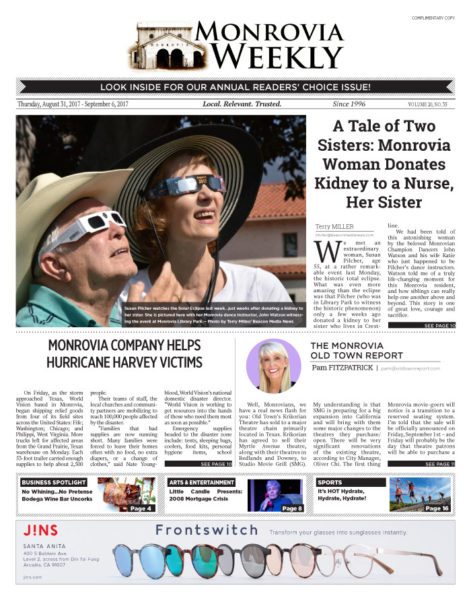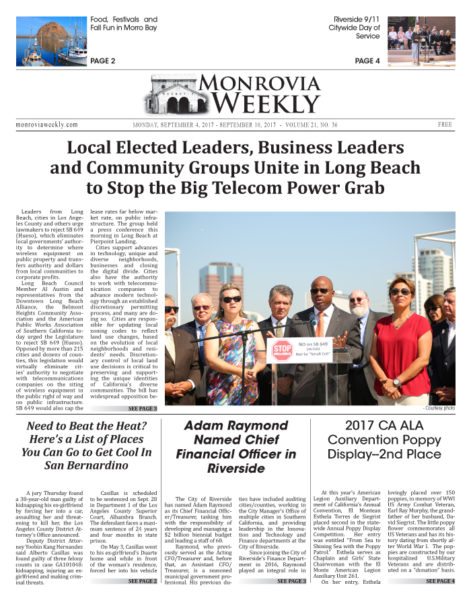
On 6 Nov 1946, Monrovia News-Post headlines read “Nixon Sweeps 12th District Vote.” This local Congressional election between two political opposites became a watershed moment in our nation’s history. The fourth of the five contentious debates between the young Whittier attorney, Richard Nixon, and 5-term Congressional representative, Jerry Voorhis, was held at Monrovia-Arcadia-Duarte (MAD) High School at 8pm on 23 October. Arthur Main, MAD teacher for the American Problems class, moderated the debate. Monrovia News-Post summed it up with this headline, “Nixon, Voorhis Argue Issues Before 1900; Packed Auditorium Cheers Candidates in Biggest Rally Here.”
Jerry Voorhis was an ardent New Dealer. Born in Kansas in 1901, he followed his father out to Southern California in 1927. Charles Voorhis was a businessman who retired to Pasadena in 1925. In 1928, father and son established the Voorhis Memorial School for Boys on 150 acres in San Dimas. The orphanage operated between 1928 and 1938. When Jerry went into politics, the land and buildings were donated to establish the “Voorhis unit” of Cal Poly San Luis Obispo. It later evolved to become Cal Poly Pomona.
A Yale graduate, Jerry Voorhis changed his political registration from Socialist to Democrat to run for the California State Senate in 1934. He ran with the other Socialist-turned-Democrat gubernatorial candidate – and Monrovian resident by 1946 – Upton Sinclair. Both Sinclair and Voorhis lost. Voorhis would then run and win the 12th District Congressional seat in 1936.
But the 12th District was changing in the post-war era. Created after the 1930 census, the 12th District would be renumbered after the 1950 census to the 25th District. In 1946, it was the largest and most rural district in LA County that covered 32 municipalities from South Pasadena to Claremont, from Monrovia to El Monte. It also included Duarte, Arcadia, and Azusa. More and more people were moving into these suburbs of Los Angeles that still had a healthy dose of citrus farms and chicken ranches. Monrovia’s population in 1940 was 12,807 and jumped to 20,186 by 1950. The Republican fathers correctly assumed that a viable candidate could challenge Voorhis hold on this Congressional seat. They hoped for the candidacy of San Marino’s favorite son, General George S. Patton – but he died in December of 1945. They turned to a Navy Lieutenant, Richard Milhous Nixon, who grew up working at his father’s grocery store in Whittier.
Young Nixon may have been a political novice but he was a hardworking campaigner with the support of the Republican “Committee of 100,” the Chandlers of the Los Angeles Times, and Southern California oil interests. Nixon spoke to the Rotary and Lions clubs, the San Gabriel and Alhambra Women’s Clubs, and everybody. Voorhis drove back to California in September and was blatantly underprepared to meet his opponent in a series of five debates in September and October at South Pasadena Junior High, Whittier’s Patriotic Hall, Pomona College, Monrovia High School, and San Gabriel Civic Auditorium.
In his opening at the MAD debate, Nixon said, “As opposed to my opponent, I am firmly against the continued socialization and nationalization of the basic industries of this country,” and “there is nothing wrong with America today that a good election will not fix.” Voorhis focused on the international agenda and veteran housing.
Nixon had the support of the press. Monrovia News-Post wrote on 3 October, “Campaign statements that Jerry Voorhis, California’s congressman, is not pro-Russian were placed in serious doubt today by a check of the official Congressional Record by the Republican National Committee. Sympathy for Russia and for left-wing programs in the U.S. is revealed in six votes by Voorhis, the record shows.”
Nixon won that House seat in 1946 with 56% of the vote. News-Post predicted a 70% turnout of Monrovia’s 9187 registered voters. Nixon retained this seat in 1948. He became senator in 1950, vice president in 1952, and president in 1968. Voorhis became the executive director of the Cooperative League of USA in Chicago – setting up food and other cooperatives. In later life, he referred to himself as “the man who Nixon beat.” He died in 1984 in Claremont.







